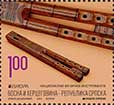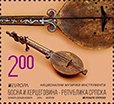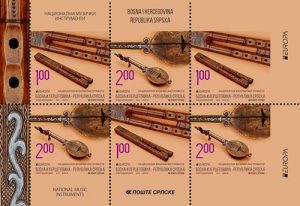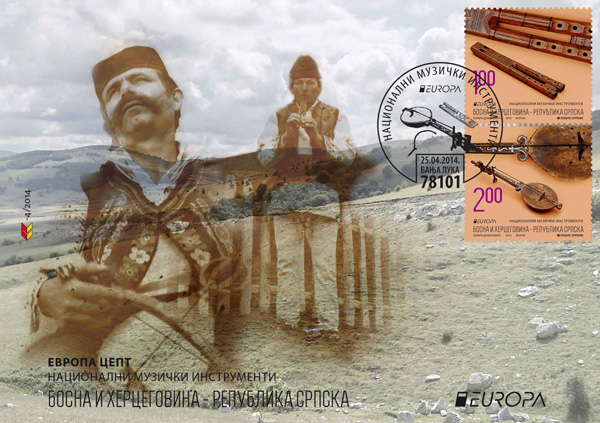Europa CEPT - National Musical Instruments
Title::Europa CEPT - National Musical Instruments
Date of Issue:25.04.2014
Author:Djumic/Dosenovic
Type edition:commemorative
Printing techniques:multicolour offset
Sheet:8+1 and booklet
Paper:muflep 100g
Printing House:Forum, Novi Sad
 Motive:dvojnice
Motive:dvojnice
Catalogue no.:629
Perforation:13 3/4
Face value:1.00 BАМ
Quantity:35 000
 Motive:fiddle
Motive:fiddle
Catalogue no.:628
Perforation:13 3/4
Face value:2.00 BAM
Quantity:35 000
 Motive:dvojnice and fiddle
Motive:dvojnice and fiddle
Catalogue no.:630
Perforation:13 3/4
Face value:9.00 BAM
Quantity:15 000

Fiddle
Traditional string stringed instrument that is commonly used to accompany epic poems. It is an instrument Dinara area (Bosnia and Herzegovina, Montenegro and Croatia), Serbia appears at Kosovo Serbs and to some extent the Albanians. They are made usually from a single piece of maple wood and consists of the following parts: neck without thresholds, pelvis is the bowl-shaped dent over which stretches the leather (sheep, lamb), the vocal cords are stretched holes in the skin which is between 5 and 10 which serve to give a better sound, then pin that is used to tighten the strings, centerboard over which the strings are stretched over the leather, button which serves to string fastened to the lower part, string which is stretched from the top to the button, and the bow is made of wood in the bend form with a 40 horse strings. Strings are adjusted (tunes) to the singer's voice. The sound is made by the bow pulls over the strained strings, producing a sharp and dramatic sound. Fiddle originate from Central Asia. Fiddle played an important role in the history of Serbian epic poetry since the minstrels - folk singers sang about events of national history for centuries.
Dvojnice
Dvojnice are popular brass instrument from the group labial played with an edge. These are actually made up of two tubes of the same length drilled in parallel. Each pipe has a hole of vocal cords and mouthpiece. The holes were drilled to have a pipe with four holes and on the other three. Number of holes depends on where the instrument originated, so dvojnice from Bosnia and Croatia have four holes on the right side and three on the left, while the Herzegovinian and Serbian vice versa. Playing on dvojnice still is in two-voice, mostly in thirds. Maximum six tones of each octave. Dvojnice is usually made of a plum tree. They are available in various sizes from 20 to 40 cm. It is mostly shepherd solo instrument but is played at gatherings. It is often used as an accompaniment to folk dances until it was suppressed by harmonics.
Author: Nebojsa Djumic and МА Bozidar Dosenovic
Publisher: Poste Srpske a.d. Banjaluka
Cooperation: MA Sanja Pupac, Museum of Republic of Srpska



